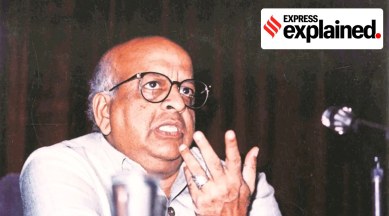Who was T N Seshan, who changed the face of Indian elections?
The Supreme Court, mooting the idea of including the Chief Justice of India in the selection process for the Chief Election Commissioner, has said a person like former CEC, the late T N Seshan, "happens once in a while".

Mooting the idea of including the Chief Justice of India in the appointment committee to select the Chief Election Commissioner (CEC) to ensure “neutrality”, the Supreme Court Tuesday (November 22) said it wants a CEC of strong character like the late T N Seshan. The apex court said the Constitution has vested enormous powers on the “fragile shoulder” of the CEC and the two Election Commissioners, and added that the CEC should be someone who “does not allow himself to be bulldozed”.
A five-judge Constitution bench, headed by Justice K M Joseph, said its endeavour was to put a system in place so the “best man” is selected as the CEC.
monthly limit of free stories.
with an Express account.
“There have been numerous CECs and T N Seshan happens once in a while. We do not want anyone to bulldoze him. Enormous power has been vested on the fragile shoulder of three men (two ECs and the CEC). We have to find the best man for the post of CEC. The question is how do we find that best man and how to appoint that best man,” the bench, also comprising Justices Ajay Rastogi, Aniruddha Bose, Hrishikesh Roy and C T Ravikumar, said.
Who was T N Seshan?
Tirunellai Narayana Iyer Seshan, or T N Seshan as he was commonly called, was appointed the Chief Election Commissioner (CEC) on December 12, 1990 with a tenure till December 11, 1996.
Born in Palakkad district of Kerala, Seshan is widely credited for ushering in electoral reforms that changed the face of Indian elections. Before becoming the CEC, Seshan had served many bureaucratic positions including the secretary to the Atomic Energy Commission and joint secretary at the Department of Space.
Established in 1950 as the constitutional authority to hold free and fair elections in India, the Election Commission of India was not more than an observer of elections until 1990. At a time when it was normal to bribe voters, Seshan enforced the authority of the EC as per its powers laid out in the Constitution. He changed the process of conducting elections in the nation and introduced a list of 150 malpractices during elections, including distribution of liquor, bribing voters, ban on writing on walls, use of religion in election speeches etc. He introduced voter ID cards, the Model Code of Conduct, and enforced a limit to poll expenses.
During the process, Seshan also had several rifts with the ruling government. In 1993, the then government under P V Narasimha Rao brought in an Ordinance with the President’s assent under Article 342(2)[3] of the Indian Constitution fixing the number of EC’s at two and appointed M S Gill and G V G Krishnamurthy as the two EC’s. Opposing this, Seshan approached the Supreme Court alleging that the move was introduced to curb his powers. His petition was dismissed by the court, and it held, “the concept of plurality is writ large on the face of Article 324, clause (2) whereof clearly envisages a multi-member Election Commission comprising the CEC and one or more ECs.”
In 1996, Seshan received the Ramon Magsaysay Award for his role in cleaning up the electoral process in the country. He also unsuccessfully contested the presidential elections against K R Narayanan in 1997. He breathed his last on November 10, 2019 in Chennai.